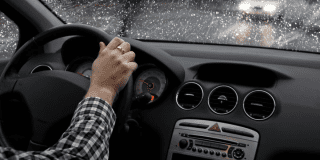How to Use Antilock Brakes
When your wheels lock up on wet and slippery roads or during a panic stop, you may lose traction and control, causing your vehicle to spin. Antilock brakes keep your wheels from locking up, so your car maintains directional control around hazards if you can’t make a complete stop in time. If you have an Antilock Brake System (ABS), make sure you check into a discount on your car insurance.
ABS is designed to help you maintain control of the vehicle during emergency braking situations, not make the vehicle stop more quickly. Although ABS will shorten stopping distances on wet or slippery roads, on very soft surfaces, such as unpacked snow or loose gravel, an ABS system may actually lengthen stopping distances.
Facts about ABS systems
• An anti-lock braking system works with the regular brakes on your vehicle.
• Your vehicle will always have its regular braking system, even if ABS were to fail.
• ABS activates only in slippery conditions or during panic stops when a driver slams on the brakes, causing them to lock up.
• The anti-lock brake system is speed sensitive, and the brake system will not activate at very slow speeds.
• Some systems are designed to prevent only the rear wheels from locking up.
• Rear-wheel-only systems are found on some older pickups and sport utility vehicles.
• Rear wheel ABS keeps your vehicle from spinning out of control; however, if the front wheels lock up, you will not have steering control.
• All other ABS systems, including those for cars and minivans, are designed to keep all four wheels from locking up.
• Four-wheel ABS will actually allow you to retain the ability to steer your vehicle while you’re still braking.
• ABS prevents wheel lockup so that your vehicle stays in a straight line.
• If you have steering control, it is possible to avoid a crash by steering around hazards if a complete stop cannot be accomplished in time.
• In vehicles equipped with ABS, the driver’s foot should remain firmly on the brake pedal, allowing the system to automatically pump the brakes.
• What ABS does is similar to a person pumping the brakes. It automatically changes the pressure in your vehicle’s brake lines to maintain maximum brake performance just short of locking up the wheels.
Practice with ABS
Effectively using brakes on a vehicle equipped with ABS requires a different technique than used on a vehicle that doesn’t have ABS. To take full advantage of the safety benefits with antilock brakes, drivers must learn how to operate their anti-lock brake systems correctly.
Empty parking lots or other open areas are excellent places to practice emergency stops. One way to familiarize yourself with the operation of ABS is to test drive the vehicle at a speed above which the ABS activates (usually above 10 mph).
Four-wheel anti-lock brake systems
• Slam on the brakes. The ABS should stop the wheels from skidding.
• You may feel the brake pedal vibrate and hear a clicking sound – this is normal.
• DON’T pump the brakes (this will deactivate ABS).
• Keep your foot firmly pressing on the brake pedal.
• Keep steering to enable four-wheel ABS to work properly.
Rear-wheel anti-lock brake systems
• In light trucks equipped with rear-wheel anti-lock brakes, the front wheels can still lock up just like as conventional brakes.
o If front wheels lock up, ease up on the brake pedal with just enough pressure to allow the front wheels to roll again so you can steer.
The antilock brake system includes a dash warning light to alert the driver when a system malfunction has been detected. If the lamp comes on while driving, the ABS system will be disabled and the system will return to standard non-ABS brake operation. Although the car can still be driven with the standard brakes operating, it should be taken in for repairs as soon as possible. Like having car insurance, you don’t want to drive without it.



